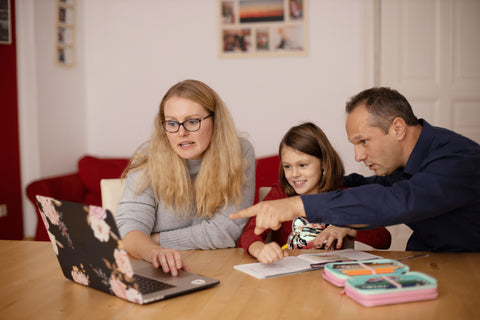
Children and their Learning Styles
Providing children the opportunity to thrive is a gift of a lifetime. One avenue that fosters this, is helping your child learn in the way that best suits them. Like many things in life, learning is not a one size fits all approach. Typically, learning styles are broken down into four main categories: visual, auditory, tactile, and kinesthetic. Having a better understanding of these different learning styles will be beneficial for both child and parent education.
Visual Learning

Visual learning is when eyesight is used to gather and understand information. There are multiple ways to engage and support visual learners. For example, the use of a fun game such as pictionary or word to picture matching might be useful. Visual learners typically like to see things in front of them versus only hearing them. They also tend to be good at visualizing.
So, when helping a visual learner, be sure to give them something to look at. Make handouts and charts vivid and colorful, or use interesting fonts to gain attention of visual learners. The goal is to provide them an opportunity to gain information in the manner that best suits them, which means helping them effectively take in what they see.
Auditory Learning
When it comes to auditory learners, they process by hearing. Auditory learners typically can easily recall spoken information. They also tend to be strong at things like oral exams. A good way to support your auditory learner or provide them with good study motivation, is to create space for discussion in the classroom or at home on the new topics they are learning. Hearing about what your child is learning gives them an opportunity to rehearse what they are taking in, but also provides an opportunity for bonding and engagement. If you know what they are learning, and how they are learning, as parents or caretakers you begin to have insight into where they may or may not need additional support.
Another strategy might be finding a way for your auditory learner to tape or record classes to listen to later. Giving them the opportunity to have information repeated to them, or having them repeat the information themselves is another good method of learning. You may find that classical music may also be useful for auditory learners. Whatever the avenue, providing auditory learners the ability to use their ears is key.
Tactile Learning
Tactile learners use physical touch as a way of gathering information. Hands-on activities are going to be best for these types of students. When supporting your tactile learner, the use of arts and crafts and sensory activities will be important. Even using songs like head shoulders, knees, and toes will help your child gather the information they need to.
In addition to these things, encouraging tactile learners to underline, highlight, or take detailed notes will facilitate them in learning new things. The most important takeaway here, is to give your tactile learner something to put their hands to, it will make a world of difference.
Kinesthetic Learning

Last up on the list is kinesthetic learning. Kinesthetic learners need to utilize the entire body when learning. There is not just an emphasis on the hands, like with tactile learners, although there is some crossover. These types of learners thrive at things like drama, sports, and various trades. You may find that it may not always be easy for kinesthetic learners to sit still at a desk in an educational setting, but that’s okay. Teachers and parents with the right resources and plan can provide these children with a hospitable learning environment.
For example, providing kinesthetic learners with frequent breaks during class or even an action based lesson is another way to aid them in thriving. In order to make study or homework time engaging, take your child outdoors, let them use chalk to write out equations or draw pictures that will help them process. In the classroom, giving your students fly swatters to race and answer questions on the board is a way to get the entire body involved in the learning process.
To Parents

The four different learning styles apply to both children and adults. While helping your little one thrive as they learn, you too can attain tools that might be useful on a day to day basis. When retaining and utilizing information learned, one of the best things someone can do for themselves is figure out what their learning style is.
As a parent, taking time to gain additional information about the various learning styles as well as fun games and activities that can be used will be beneficial to the growth and development of your child. The educational foundation of your child begins at home, and there are a few practical ways you can support your child's learning style.
Taking time to listen to songs such as the ABC’s, or songs that teach rhyming, is an easy way to support your auditory learner. Giving your tactile learner a chance to use measuring cups while baking is a fun and rewarding method to help them better comprehend fractions or math problems. Quizzing your kinesthetic learner and allowing them to hop on answers written on the ground or a mat is a great way to ensure they are retaining information. For your visual learner, using poster boards to create decorative diagrams and resource material is an interactive way to encourage them as they learn.
Knowing how you or your child learns can be truly empowering. Not just in school, but also at home. There is no one way, or right way to learn, the four different learning styles are proof of that. Observe your child and see how you can best support them whether they are a tactile, auditory, kinesthetic, or visual learner. The main goal is to see your little one flourish.
